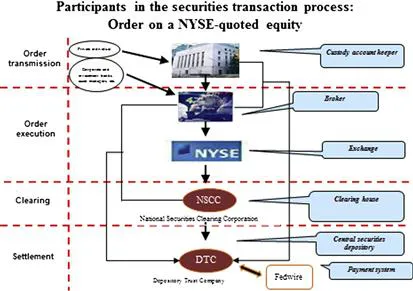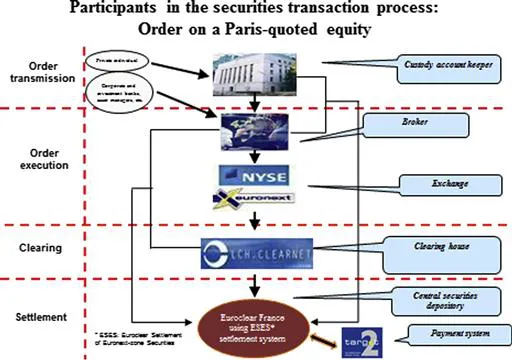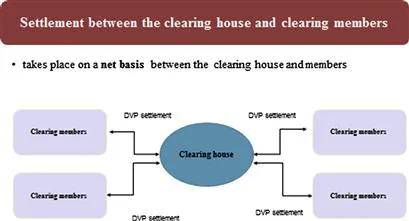![]()
Chapter 1
The structure of clearing and settlement
Abstract
This chapter introduces the concepts of clearing and settlement. It discusses the process in respect of payments and securities identifying the key systems. The chapter also looks at the evolution of clearing and settlement and the key recommendations that have shaped the processes used today.
The role of the clearing house and an overview of the major providers of central clearing are explored including DTCC, Euroclear and Euroclear Great Britain and Ireland (CREST), Clearstream, LCH Clearnet, TARGET2.
We look at the flow for a transaction through to settlement seeing how each player is involved.
Keywords
clearing; settlement; clearing house; securities depositories; payments; central clearing; G30
What is clearing and settlement?
An interesting question and one that, on the face of it, could be answered by a simple definition and yet in the financial markets it is often a very little understood but vital process.
For every transaction that takes place in the markets there is a process that concludes the transaction. In general terms that will mean some kind of exchange taking place between the two parties to the trade. The exchange may be cash for a security or the netted outcome of more than one transaction, for instance the end result of a purchase and sale.
Clearing is a term that is easily associated with banking so that we have the ‘clearing banks’. In this instance the item being ‘cleared’ is money and, historically, cheques. When a cheque is drawn it has a value that is only realized when the receiving bank has presented it to the drawing bank and received the value, hence the term ‘value date’. As most people know, the time to obtain the value may be three or even more days from the paying into the account of the cheque. Today the somewhat antiquated process of cheques being cleared has been partially replaced by automated processes or electronic banking. The payment systems that allow electronic transfer of money are usually owned and operated by the Central Bank of the country of the currency. Example of payment systems are Fed Wire and CHIPS in the USA, BACS and CHAPS in the UK and TARGET2 for the Euro. However small or low-value payments can in many cases take several days before the clearing is completed.
In the financial markets there is not only cash but also near cash or money market instruments like treasury bills. A transaction in these bills is settled in the UK through the CREST system at Euroclear. Euroclear UK and Ireland (Euroclear) provides via CREST the UK securities settlement service for both money market instruments and also UK and international securities and bonds. This includes equities, bonds, unit trusts and shares in open-ended investment companies (OEICs).
In the USA treasury instruments are cleared via the Government Securities Clearing Corporation (GSCC) and in Europe via TARGET2.
So we know that money is cleared and settled in banking and so are securities including treasury instruments, equities, debt as well as commodities and derivatives; although the processes may be very different.
We looked at clearing and settlement in the overview so we can look again at what the two terms mean.
The process of clearing can be defined as:
The preparation through matching, recording and processing instructions of a transaction for settlement.
Settlement can be defined as:
The exchange of cash or assets in return for other assets or cash and transference of the ownership of those assets and cash.
In each market around the world transactions in financial market instruments follow the same basic principle of clearing and settlement. The process of clearing and settlement is often linked with another process, the holding of securities. When this occurs we find central securities depositories or CSDs for short. CSDs hold securities centrally on behalf of their members to speed the process of clearing and settlement. This is particularly relevant where physical securities still exist as the selling party does not have to send the securities to the buying party who may be resident overseas. The risk in moving physical securities is the possibility of the loss of the securities. As noted, this is extremely important in the case of bearer securities where there is no evidence of ownership recorded.
We should also note at this point that CSDs and International Central Securities Depositories (ICSDs) like Euroclear, Clearstream and DTCC only operate in instruments they have approved as ‘eligible’. We cannot forget that a wide range of instruments cannot be processed via a CSD or for that matter a CCP, for example private equity, which are shares in small unlisted or privately owned companies.
The clearing house
It is important to note that the clearing process is carried out by a designated function, and the organization that performs this function is often called a clearing house. The clearing house operates either completely or to a significant degree independently of the exchanges or market it serves. The responsibility for managing and overseeing the trading process is therefore quite separate from the process of controlling the transactions through to settlement. The clearing house does not make the rules and regulations pertaining to carrying out transactions but it does establish the rules, in conjunction with the regulator and the exchange, by which its members will clear and settle the business.
Figure 1.1 shows the process associated with an equity transaction on the NYSE whilst Figure 1.2 shows the process for a trade on NYSE Euronext in Paris.
FIGURE 1.1 The process associated with an equity transaction on the NYSE.
FIGURE 1.2 The process for a trade on NYSE Euronext in Paris. Source: The DSC Portfolio Ltd/First Finance.
We can see where some of the participant organizations that we have mentioned are located in the trade and post-trade clearing and settlement process, including the CSD and payment systems.
The relationship between the clearing house and its members is that the clearing house settles trades on a net basis between itself and its members. Netting means that bought and sold trades are offset and the cash position across trades is also netted. The opposite to netting is gross settlement, which is where every trade settles separately. Figure 1.3 above illustrates this and as we can see not only is netting applied, but also settlement takes place on a delivery versus payment (DVP) process, which again helps to reduce the risk of failed settlement.
FIGURE 1.3 Source: The DSC Portfolio Ltd/First Finance.
Changes in clearing
We noted in the overview that today, as with so much of the financial markets, change is taking place in the way in which activity on markets is cleared and settled.
Let us recap on this and explore further.
The central clearing counterparty (CCP), essentially a process of not just facilitating settlement but guaranteeing it, is becoming common in securities markets and thus the clearing and settlement of securities is moving towards the same process as that used for derivatives.
In the UK, the London Clearing House (LCH), a major clearer of derivatives for many years, joined with CREST to provide a central clearing process for equities called EquityClear.
In Figures 1.1–1.3 above we saw the possible relationships between the trading, clearing and settlement and the relationship with the CCP. Note that there need not necessarily be a one-to-one relationship between the trading member as legal entity and either the clearing member or the settlement entity.
We look at the CCP again in more detail later in the book but it is important to remember that the changes in clearing and settlement are impacting on operations teams and, of course, the procedures and controls they use. There are many benefits, as we have already determined of the CCP structure, but there is also a need to ensure that firms and clients are aware of what the changes mean to long-established procedures, particularly in areas like some OTC derivatives where the concept is new.
We also need to focus on the fact that clearing and settlement processes in different markets are covered by local conventions and in turn these differ sometimes considerably from jurisdiction to jurisdiction and also from one product to another.
Development of the clearing structures
The introduction of many initiatives over the years has led to a more streamlined process and yet one that is by no means uniform across countries. These initiatives include those set out by the Group of 30, an industry body made regarding issues surrounding the settlement of securities in the late 1980s. The International Securities Services Association (ISSA) later took on board the recommendations that they made, updated them and monitored markets to ascertain the extent of their implementation. Today we see many of the recommendations as standard practice in most, but not all, markets. Times have changed, and ISSA issued more recommendations in 2000 that sought to build on those of G30 and improve the whole settlement environment from the angles of both efficiency and risk. It is worth looking at the G30 and ISSA 2000 recommendations and the key points follow:
Insight
Group of 30 recommendations
1 All comparisons of trades between direct market participants (i.e. brokers, broker dealers and other exchange members) should be accomplished by T+0. Matched trade details should be linked to the settlement system.
2 Indirect market participants (such as institutional investors, and other indirect trading counterparties) should achieve positive affirmation of trade details on T+1.
3 Each country should have in place an effective and fully developed central securities depository, organized and managed to encourage the broadest possible direct and indirect industry participation. The range of depository eligible instruments should be as wide as possible. Immobilization or dematerialization of financial instruments should be achieved to the utmost extent possible.
4 Each market is encouraged to reduce settlement risk by introducing either Real Time Gross Settlement or a trade netting system that fully meets the ‘Lamfalussy Recommendations’.
5 Delivery versus payment (DVP) should be employed as the ...



